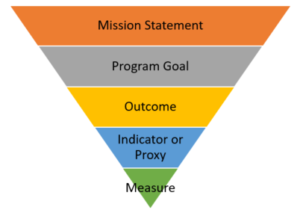In my last post, I argued that you can’t measure what you haven’t defined. Too many nonprofits try to measure broad or vague outcome statements, which results in confusing surveys and largely useless data. Identifying clear, specific indicators makes measurement easier and more meaningful.
Indicators are the critical middle step between outcomes and measurement tools. Your indicators can tell you what to measure and how. They are the translator, the Rosetta Stone, if you will.
However, as many of my clients and students have pointed out, the outcomes we seek are often hard to define and measure. They are not visible to the naked eye. They do not have objective definitions. Human service organizations are in the business of changing hearts, minds, relationships, and lives. And those can be hard to measure. Attitudes, beliefs, and feelings are some of our most meaningful outcomes and some of the most difficult to measure!
How Do You Measure That?!
When measuring these types of outcomes, indicators are especially important. There are two primary ways you can try to measure the things you can’t see:
- You can ask clients to self-report.
- You can observe something related.
Asking Clients to Self-Report: Surveys & Assessments
Here are some of my best tips for surveying clients:
- Adopt or adapt standardized measures whenever possible. They are more available than you might think. (Click here to find some great resources for finding measures.)
- If you must create your own, follow basic best practices for survey design (more on that next month).
- Be mindful of how and when you ask, who does the asking, and who sees the answers. These factors can impact the answers you get.
But sometimes, asking clients to self-report isn’t feasible or desirable. For example, when you are assessing children, individuals with cognitive limitations, or involuntary clients, it can be difficult to get accurate self-reports in which you’d be confident.
Proxy Indicators: The Next Best Thing
In cases when client self-report isn’t feasible or isn’t likely to yield useful data, you can drill down to “proxy indicators.” Proxy indicators are indirect measures that can approximate or represent a phenomenon, when direct measures aren’t available.
For example, if you can’t survey clients to assess self-esteem, what behaviors might you able to observe that represent self-esteem? Body language, the quality of self-descriptive statements, engagement, participation, self-care, etc. If you can’t ask students how engaged they feel in school, what behaviors might you observe to approximate that? Attendance, participation in class, enrollment in extra-curriculars, etc.
Just be clear when you write your outcome statements what indicators you’re using. Here’s my beloved mad lib:
____% of clients who ______ will _______, as indicated by ________.
A Word About Jargon
I know that the jargon associated with outcomes measurement can make your head spin. I encourage you not to get hung up on the terms themselves but instead to focus on the relationships between them and the questions they answer. 
As I use the terms, they progress this way, getting increasingly more specific as you simply ask over and over again, “What does that mean? What does that look like? How will I know?”
To be honest, in my experience, easily more than 50% of measurement problems can be solved just by answering those questions thoughtfully and consistently before you select or design your measurement tool.
It’s not too late! We have a couple spots left in our February 2018 cohort for Operation: Outcomes. If your organization is ready to get serious about measuring meaningful outcomes in manageable ways, this program is designed for you! Affordable, accessible, and intuitive! Check it out!
